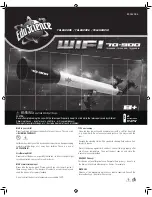
I
31
Big
Dipper
Lile Dipper
Cassiopeia
N.C.P
Polaris
(North Star)
Point
er Star
s
Many methods of polar alignment require that you know how
to find the celestial pole by identifying stars in the area. For
those in the northern hemisphere, finding the celestial pole
is not too difficult. Fortunately, we have a naked eye star less
than a degree away. This star, Polaris, is the end star in the
HANDLEOFTHE,ITTLE$IPPER3INCETHE,ITTLE$IPPERTECHNICALLY
called Ursa Minor) is not one of the brightest constellations
in the sky, it may be difficult to locate from urban areas. If this
ISTHECASEUSETHETWOENDSTARSINTHEBOWLOFTHE"IG
Dipper (the pointer stars). Draw an imaginary line through
THEMTOWARDTHE,ITTLE$IPPER4HEYPOINTTO0OLARIS4HE
POSITIONOFTHE"IG$IPPERCHANGESDURINGTHEYEARAND
THROUGHOUTTHECOURSEOFTHENIGHT7HENTHE"IG$IPPER
is low in the sky (i.e., near the horizon), it may be difficult to
locate. During these times, look for Cassiopeia. Observers in
the southern hemisphere are not as fortunate as those in the
northern hemisphere. The stars around the south celestial
pole are not nearly as bright as those around the north. The
closest star that is relatively bright is Sigma Octantis. This
star is just within naked eye limit (magnitude 5.5) and lies
about 59 arc minutes from the pole.
Long Exposure Prime Focus Photography
This is the last form of celestial photography to be attempted
after others have been mastered. It is intended primarily for
deep sky objects, that is, objects outside our solar system
including star clusters, nebulae, and galaxies. While it may
seem that high magnification is required for these objects,
just the opposite is true. Most of these objects cover large
angular areas and fit nicely into the prime focus field of your
telescope. The brightness of these objects, however,
requires long exposure times and, as a result, are rather
difficult.
There are several techniques for this type of photography,
and the one chosen will determine the standard accessories
needed. The best method for long exposure deep sky astro-
photography is with an off-axis guider. This device allows you
to photograph and guide through the telescope simultaneously.
In addition, you will need a T-Ring to attach your camera to
the Radial Guider.
Other equipment needs include an autoguider, which is a
small camera that attaches to the radial guider and keeps
your guide star centered while you are imaging with your
main camera. Here is a brief summary of the technique.
1. Polar align the telescope. For more information on polar
aligning, see the Polar Alignment section earlier in the
manual.
2. Remove all visual accessories.
3. Thread the Radial Guider onto your telescope.
4. Thread the T-Ring onto the Radial Guider.
5. Mount your camera body onto the T-Ring the same
as you would any other lens.
3ETTHESHUTTERSPEEDTOTHEh"vSETTING
7. Focus the telescope on a star.
8. Center your subject in the field of your camera.
9. Using your autoguider, find a suitable guide star in the
telescope field. This can be the most time-consuming
part of the process.
10. Open the shutter using a cable release.
11. Monitor your guide star for the duration of the exposure
using the buttons on the hand controller to make the
needed corrections.
12. Close the camera’s shutter.
Periodic Error Correction (PEC)
Periodic Error Correction, or PEC for short, is a system
that improves the tracking accuracy of the drive by reducing
the number of user corrections needed to keep a guide
star centered in the eyepiece. PEC is designed to improve
imaging quality by reducing the amplitude of the worm errors.
Using the PEC function is a three-step process. First, the
Advanced VX mount needs to know the current position of
its worm gear, so it has a reference when playing back the
recorded error. Next, you must guide using an autoguider for
at least 10 minutes during which time the system records
the correction you make. (It takes the worm gear 10 minutes
to make one complete revolution). This “teaches” the PEC
chip the characteristics of the worm. The periodic error of
the worm gear drive will be stored in the PEC chip and used
to correct periodic error. The last step is to play back the
CORRECTIONSYOUMADEDURINGTHERECORDIEEPIN
mind, this feature is for advanced astrophotography and still
requires careful guiding since all telescope drives have some
periodic error.
Using Periodic Error Correction
Once the telescope has been properly polar aligned, select
PEC from the Utilities menu and select the Record option.
Here’s how to use the PEC function:
1. Find a bright star relatively close to the object you want
to image.
2. Insert the autoguider into the eyepiece holder of your
telescope. Orient the guider so that one axis of the
sensor is parallel to the declination axis while the other
is parallel to the R.A. axis.
3. Focus the telescope, and study the periodic movement.
Содержание Advanced VX 12026
Страница 1: ...Series Telescopes INSTRUCTION MANUAL For Models 91519 32054 32062 22020 12079 12026 12046 12067 12031 ...
Страница 2: ......
Страница 4: ......
Страница 35: ......
Страница 36: ......





































